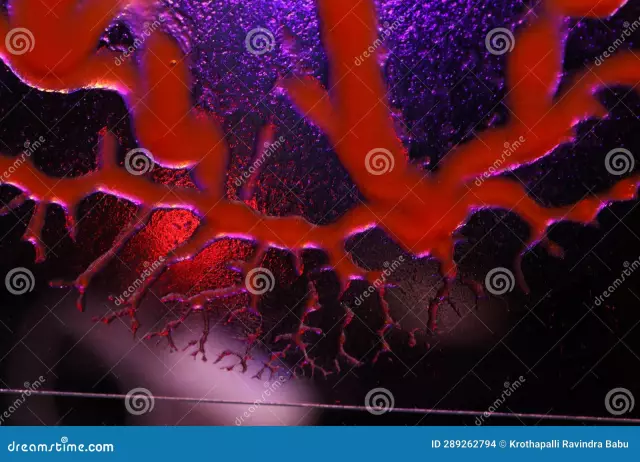- Author Curtis Blomfield [email protected].
- Public 2023-12-16 20:44.
- Last modified 2025-01-23 17:01.
Mammals and humans have the most complex circulatory system. It is a closed system consisting of two circles of blood circulation. Providing warm-bloodedness, it is more energetically favorable and allows a person to occupy the habitat niche in which he is currently located.
The circulatory system is a group of hollow muscular organs responsible for the circulation of blood through the vessels of the body. It is represented by the heart and vessels of different calibers. These are muscular organs that form circles of blood circulation. Their scheme is offered in all textbooks on anatomy and is described in this publication.

The concept of circulatory circles
The circulatory system consists of two circles - bodily (large) and pulmonary (small). The circulatory system is called the system of vessels of the arterial, capillary, lymphatic and venous type, which supplies blood from the heart to the vessels and its movement in the opposite direction. The central organ of blood circulation is the heart, since two circles cross in it without mixing arterial and venous bloodcirculation.
Systemic circulation

The system of providing peripheral tissues with arterial blood and its return to the heart is called the system of blood circulation. It starts from the left ventricle, from where blood exits into the aorta through the aortic orifice with a tricuspid valve. From the aorta, blood is directed to the smaller bodily arteries and reaches the capillaries. This is a set of organs that form the adductor link.
Here, oxygen enters the tissues, and carbon dioxide is captured from them by red blood cells. Also, blood transports amino acids, lipoproteins, glucose into the tissues, the metabolic products of which are carried out of the capillaries into venules and further into larger veins. They drain into the vena cava, which return blood directly to the heart in the right atrium.
The systemic circulation ends with the right atrium. The scheme looks like this (in the course of blood circulation): left ventricle, aorta, elastic arteries, muscular-elastic arteries, muscular arteries, arterioles, capillaries, venules, veins and vena cava, returning blood to the heart in the right atrium. From a large circle of blood circulation, the brain, all skin, and bones are fed. In general, all human tissues are fed from the vessels of the systemic circulation, and the small one is only a place of blood oxygenation.
Lesser circulation
Pulmonary (small) circulation, the scheme of which is presented below, originates from the right ventricle. Blood enters it from the right atrium through the atrioventricularhole. From the cavity of the right ventricle, oxygen-depleted (venous) blood enters the pulmonary trunk through the output (pulmonary) tract. This artery is thinner than the aorta. It divides into two branches that go to both lungs.
The lungs are the central organ that forms the pulmonary circulation. The human diagram described in anatomy textbooks explains that pulmonary blood flow is needed to oxygenate the blood. Here it gives off carbon dioxide and takes in oxygen. In the sinusoidal capillaries of the lungs with a diameter atypical for the body of about 30 microns, gas exchange takes place.
Subsequently, oxygenated blood is sent through the system of intrapulmonary veins and collected in 4 pulmonary veins. All of them are attached to the left atrium and carry oxygen-rich blood there. This is where circulation circles end. The scheme of the small pulmonary circle looks like this (in the direction of blood flow): right ventricle, pulmonary artery, intrapulmonary arteries, pulmonary arterioles, pulmonary sinusoids, venules, pulmonary veins, left atrium.
Features of the circulatory system

A key feature of the circulatory system, which consists of two circles, is the need for a heart with two or more chambers. Fish have only one circulation, because they do not have lungs, and all gas exchange takes place in the vessels of the gills. As a result, the fish heart is single-chamber - it is a pump that pushes blood in only one direction.
Amphibians and reptiles have respiratory organs and, accordingly, circulatory circles. Scheme themThe work is simple: from the ventricle, blood is directed to the vessels of the large circle, from the arteries to the capillaries and veins. Venous return to the heart is also implemented, however, from the right atrium, blood enters the common ventricle for the two circulations. Since the heart of these animals is three-chambered, the blood from both circles (venous and arterial) is mixed.
In humans (and mammals) the heart has a 4-chamber structure. In it, two ventricles and two atria are separated by partitions. The lack of mixing of two types of blood (arterial and venous) was a giant evolutionary invention that ensured warm-blooded mammals.

Blood supply to the lungs and heart
In the circulatory system, which consists of two circles, nutrition of the lungs and heart is of particular importance. These are the most important organs that ensure the closure of the bloodstream and the integrity of the respiratory and circulatory systems. So, the lungs have two circles of blood circulation in their thickness. But their tissue is nourished by the vessels of a large circle: bronchial and pulmonary vessels branch off from the aorta and intrathoracic arteries, carrying blood to the lung parenchyma. And the organ cannot be fed from the right parts, although part of the oxygen diffuses from there as well. This means that the large and small circles of blood circulation, the scheme of which is described above, perform different functions (one enriches the blood with oxygen, and the second sends it to the organs, taking deoxygenated blood from them).
The heart is also fed from the vessels of the large circle, but located in its cavitiesblood is able to provide oxygen to the endocardium. In this case, part of the myocardial veins, mostly small ones, flows directly into the chambers of the heart. It is noteworthy that the pulse wave to the coronary arteries extends into cardiac diastole. Therefore, the organ is supplied with blood only when it "rests".

This is interesting
Circulation of human circulation, the scheme of which is presented above in the relevant sections, provides both warm-bloodedness and high endurance. Although man is not the animal that often uses his strength to survive, it has allowed the rest of the mammals to populate certain habitats. Previously, they were inaccessible to amphibians and reptiles, and even more so to fish.
In phylogeny, the big circle appeared earlier and was characteristic of fish. And the small circle supplemented it only in those animals that completely or completely went out onto land and settled it. Since its inception, the respiratory and circulatory systems have been considered together. They are functionally and structurally related.
This is an important and already indestructible evolutionary mechanism for moving out of aquatic habitats and settling on land. Therefore, the continuing complication of mammalian organisms will now go not along the path of complicating the respiratory and circulatory systems, but in the direction of strengthening the oxygen-binding function of the blood and increasing the area of the lungs.






